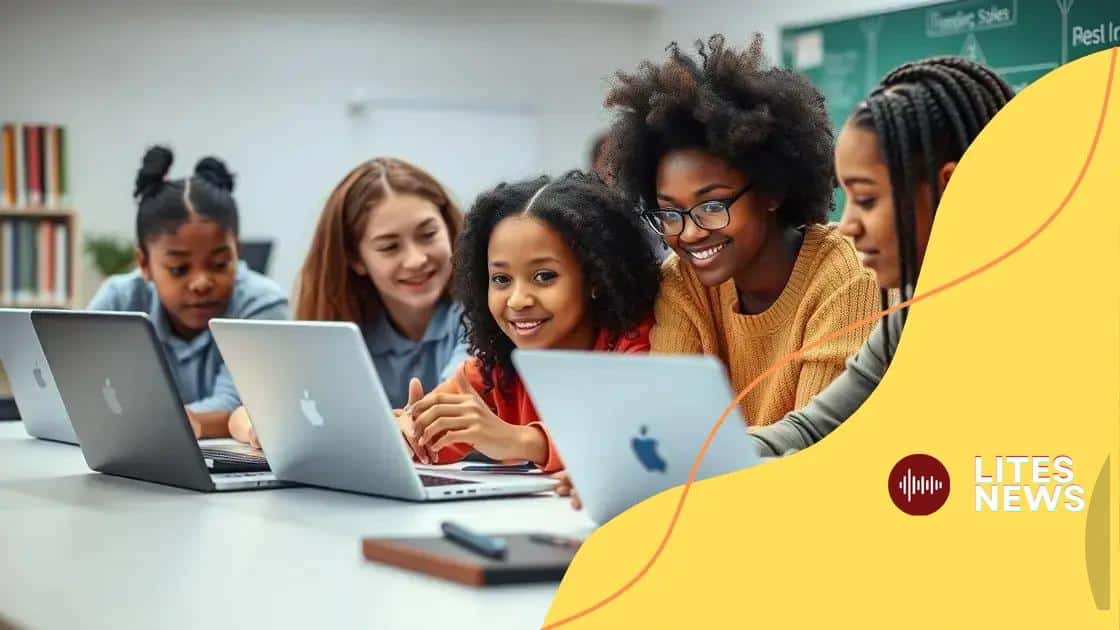Collaborative digital classrooms: transforming learning experiences

Collaborative digital classrooms utilize technology to foster teamwork and engagement, enabling personalized learning experiences that prepare students for future success and enhance educational outcomes.
Collaborative digital classrooms are changing the way we perceive education, bringing opportunities for interaction and shared learning. Have you imagined how this might influence student engagement and outcomes? Let’s dive deeper into the idea.
Understanding collaborative digital classrooms
Understanding collaborative digital classrooms means exploring how technology reshapes learning environments. These classrooms promote active participation, enabling students to learn together, regardless of their physical location.
The Role of Technology
Technology is at the heart of collaborative digital classrooms. It connects students and teachers through various platforms, making learning interactive and engaging. Students can share resources, ideas, and feedback instantly.
Key Elements for Successful Collaboration
- Communication tools: Using tools like video conferencing helps in real-time discussions.
- Shared resources: Platforms like Google Drive allow simultaneous document editing.
- Feedback mechanisms: Continuous feedback ensures everyone on the team grows and improves.
In collaborative digital classrooms, the sense of community grows stronger. Students benefit from diverse perspectives, enhancing their understanding of various subjects. As they collaborate, they learn important life skills such as teamwork, problem-solving, and communication. These skills are essential for their future careers.
Furthermore, this collaborative approach provides students with a sense of ownership. When they partake in discussions, they feel responsible for their learning process. This responsibility drives them to be more engaged and proactive.
Challenges in Collaboration
Despite the advantages, there are challenges. Students need to develop digital literacy to navigate tools efficiently. Additionally, some might feel isolated when working remotely. Educators must create an inclusive environment where everyone feels valued.
Ultimately, collaborative digital classrooms hold great potential for enhancing education. They engage students through active learning experiences, preparing them for future endeavors. By leveraging technology, educators can create dynamic learning atmospheres where every student can succeed.
Key benefits for students and teachers
The key benefits of collaborative digital classrooms are significant for both students and teachers. These environments foster engagement and participation, creating a dynamic learning experience.
Enhanced Learning Experiences
Students in these classrooms enjoy a richer learning experience. They learn from each other, share diverse perspectives, and develop critical thinking skills. Active participation is encouraged, making learning more enjoyable and effective.
Benefits for Students
- Improved communication: Collaborating with peers hones their communication skills.
- Increased motivation: Group projects and shared goals motivate students to perform well.
- Personalized learning: Students can engage with material at their own pace.
This collaborative model allows students to take ownership of their education. They are more likely to stay engaged and curious when they can contribute to discussions. Moreover, this approach helps build essential skills that will help them in their future careers.
Teachers also benefit from collaborative digital classrooms. They can tailor their teaching methods to meet diverse learning needs. With students working together, teachers can facilitate rather than directly instruct, which promotes a deeper understanding of the material at hand.
Benefits for Teachers
- Efficient classroom management: Collaborative groups can lead to smoother classroom dynamics.
- Professional development: Teachers can learn from each other’s strategies and experiences.
- Data-driven insights: They can track student progress more effectively through collaborative tools.
Ultimately, these benefits contribute to a stronger educational environment. As students and teachers work together, they foster a culture of collaboration that enhances learning outcomes for everyone involved.
Tools and technologies for effective collaboration

Tools and technologies play a vital role in effective collaboration within collaborative digital classrooms. They provide students and teachers with the resources needed to engage and learn together seamlessly.
Essential Collaboration Tools
Various tools can enhance collaboration in a digital classroom. By using the right technologies, educators can create an interactive and engaging learning environment.
- Learning Management Systems (LMS): Platforms like Google Classroom and Moodle help organize course materials, assignments, and communications.
- Communication Tools: Applications such as Slack and Microsoft Teams enable real-time discussions and sharing of ideas.
- Collaborative Document Editing: Tools like Google Docs and Office 365 allow multiple users to edit documents simultaneously.
- Virtual Whiteboards: Platforms like Jamboard offer interactive spaces where students can brainstorm and work together visually.
When students use these tools, they can easily share their thoughts and collaborate on projects. This type of engagement leads to deeper learning experiences. Additionally, teachers can monitor student progress in real-time, giving them the ability to offer immediate feedback when necessary.
Integrating Technologies in Learning
Successful integration of technology into the classroom requires planning. Teachers must choose the right tools that fit their teaching style and students’ needs. With the use of technology, teaching methods can be adapted to various learning styles, ensuring that every student benefits.
Another important aspect is to provide training for both students and teachers. Understanding how to effectively use the tools can dramatically increase their potential. With proper training, students become more confident in using technology, which enriches their learning experience.
As we explore the tools and technologies for effective collaboration, it becomes clear that these resources enhance the overall educational experience. By harnessing technology, classrooms can foster a collaborative spirit that prepares students for future success.
Strategies to implement collaboration in classrooms
Implementing collaboration in classrooms requires effective strategies that engage students and enhance learning. By focusing on a few key methods, educators can create an environment where students thrive.
Encouraging Group Work
One powerful strategy is to encourage group work. When students collaborate in small teams, they can share ideas and learn from one another. This approach promotes active learning and helps students develop critical thinking skills.
- Structured roles: Assign specific roles within the group to ensure everyone contributes.
- Clear objectives: Set clear, achievable goals for group tasks to keep students focused.
- Feedback sessions: Regularly schedule time for groups to share progress and challenges.
By using group work effectively, teachers foster a sense of community in the classroom. Students feel more comfortable expressing their thoughts and opinions, leading to deeper discussions.
Utilizing Technology
Another strategy is to incorporate technology into collaborative activities. Digital tools enable students to connect and communicate, even when they are not in the same location. By using platforms like Google Docs or Zoom, students can work together on projects seamlessly.
It is also essential to provide training on these tools. When students learn how to use technology effectively, they become more engaged in their collaborative efforts. Moreover, technology allows for flexibility, making it easier for students to collaborate outside of traditional class hours.
Finally, teachers should model collaboration. By demonstrating effective collaboration in their teaching practices, educators can inspire students to adopt similar approaches in their own work. This modeling helps students understand the value of teamwork and shared learning experiences.
As we explore these strategies, it is clear that implementing collaboration in classrooms can significantly enhance the learning experience. By promoting group work, utilizing technology, and modeling collaboration, educators can create dynamic learning environments that prepare students for future success.
Future trends in digital learning environments
The future of digital learning environments is bright, with many exciting trends shaping the way students and teachers interact and learn. As technology advances, these environments will become even more engaging and effective.
Personalized Learning Experiences
One significant trend is the move towards personalized learning. This approach allows students to learn at their own pace and focus on areas that interest them. By using data analytics, educators can tailor lessons to meet individual needs, ensuring that each student receives the support they require.
- Adaptive learning technologies: Tools that adjust based on student performance.
- Customized content: Learning materials that fit different learning styles and speeds.
- Integrated assessments: Continuous assessment methods to track progress.
This focus on individual needs not only enhances engagement but also promotes self-directed learning. Students become active participants in their education, which can increase motivation and success.
Integration of Artificial Intelligence
The integration of artificial intelligence (AI) is another trend that will impact digital learning environments. AI can streamline administrative tasks, allowing teachers to spend more time focusing on their students. Furthermore, AI-driven platforms can provide instant feedback to students, helping them improve their performance in real-time.
Moreover, AI can assist in identifying students who may need extra support, enabling timely intervention. This proactive approach ensures that no student falls behind.
Virtual and Augmented Reality
Virtual reality (VR) and augmented reality (AR) are set to transform educational experiences. These technologies create immersive learning environments that can enhance understanding and retention of complex concepts.
For example, students studying biology can explore a virtual human body, while those learning history can take virtual field trips to ancient civilizations. These experiences make learning more interactive and memorable, fostering a deeper connection to the subject matter.
Overall, the future of digital learning environments looks promising. With personalized learning, the integration of AI, and the use of VR and AR, the educational landscape will continue to evolve. As these trends take shape, they will enhance the way students learn, collaborate, and succeed in their academic journeys.
FAQ – Frequently Asked Questions about Collaborative Digital Classrooms
What are collaborative digital classrooms?
Collaborative digital classrooms are learning environments that leverage technology to foster teamwork and interactive learning among students.
How can technology enhance collaboration in classrooms?
Technology provides tools for communication, sharing resources, and real-time feedback, making collaborative projects easier and more effective.
What are the benefits of personalized learning in digital classrooms?
Personalized learning allows students to progress at their own pace, focusing on their interests and strengths, which increases engagement and understanding.
What role does AI play in collaborative digital classrooms?
AI can offer personalized learning experiences, automate administrative tasks, and provide instant feedback to students, enhancing their educational journey.





